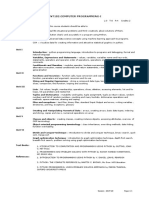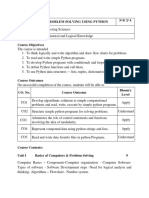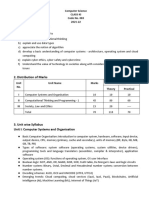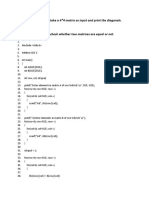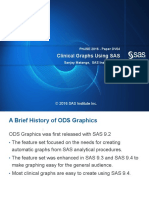Problem - Solving in Computer Programming Syllabus
Uploaded by
punamd031Problem - Solving in Computer Programming Syllabus
Uploaded by
punamd031Problem - Solving in Computer Programming
Course Objectives-The students should be able to:
1. Acquire programming skills using Python or equivalent.
2. Understand the programming basics (operations, control structures, data types, etc.)
3. Readily use the Python or equivalent programming language
4. Apply various data types and control structure
5. Understand and begin to implement code
Course Outcomes:
Upon completion of the course, students will be able to:
CO1: Develop algorithmic solutions to simple computational problems.
CO2: Write simple Python or equivalent programs using conditionals and looping for solving
problems.
CO3: Decompose a Python or equivalent program into functions.
CO4: Represent compound data using Python or equivalent domains.
UNIT 1
Fundamentals of Computing – Identification of Computational Problems -Algorithms, building
blocks of algorithms (statements, state, control flow, functions), notation (pseudo code, flow
chart, programming language), algorithmic problem solving, simple strategies for developing
algorithms (iteration, recursion).
UNIT 2
Data types, Expressions, Statements - Interpreter and interactive mode, debugging; values and
types: int, float, boolean, string, and list; variables, expressions, statements, tuple assignment,
precedence of operators, comments.
UNIT 3
Control Flow, Functions, Strings - Conditionals: Boolean values and operators, conditional
(if), alternative (if-else), chained conditional (if-elif-else); Iteration: state, while, for, break,
continue, pass; return values, parameters, local and global scope, function composition,
recursion; Strings: string slices, immutability, string functions and methods, string module; Lists
as arrays.
UNIT 4
Lists, Tuples, Dictionaries, Sets - Lists: list operations, list slices, list methods, list loop,
mutability, aliasing, cloning lists, list parameters; Tuples: tuple assignment, tuple as return value;
Dictionaries: operations and methods; advanced list processing – list comprehension, operations
on sets.
HOD CSE Dean Academics
UNIT 5
Files, Modules, Packages - Files and exception: text files, reading and writing files, errors and
exceptions, handling exceptions, modules, packages, standard libraries.
Text Books:
1. Fluent Python: Clear, Concise, and Effective Programming (1st Edition)
2. Burkhard A. Meier Packet “Python GUI Programming Cookbook: 1st Edition, 2015
Reference Books:
1. Allen Downey “Think Python” O’Reilly 1st 2012
2. Thomas Erl, Zaigham Mahmood, and Ricardo “An Introduction to Computer Science using
Python” 3 SPD 1st 2014
3. E. Balagurusamy “Introduction to Problem Solving with Python” TMH 1st 2015
4. Jake VanderPlas, “Python Data Science Handbook: Essential Tools for Working with Data”,
1st Edition, O'Reilly Media, 2016. ISBN-13: 978-1491912058
5. Aurelien Geron, “Hands-On Machine Learning with Scikit-Learn and TensorFlow: Concepts,
Tools, and Techniques to Build Intelligent Systems”, 2nd Edition, O’Reilly Media, 2019. ISBN –
13: 978-9352139057.
NPTEL: https://nptel.ac.in/courses/106106145
HOD CSE Dean Academics
You might also like
- Predicting The Churn in Telecom IndustryNo ratings yetPredicting The Churn in Telecom Industry9 pages
- Syllabus_Programming for Problem SolvingNo ratings yetSyllabus_Programming for Problem Solving2 pages
- Course Plan of Programing Language 1 (Python)No ratings yetCourse Plan of Programing Language 1 (Python)7 pages
- 19cs301problem Solving and Python ProgrammingNo ratings yet19cs301problem Solving and Python Programming3 pages
- DS225_Industry Coding Practice(Python and R)_Sangeeta.docxNo ratings yetDS225_Industry Coding Practice(Python and R)_Sangeeta.docx5 pages
- Class XI,XII Curriculum Computer Science 2025-26No ratings yetClass XI,XII Curriculum Computer Science 2025-2630 pages
- 22PLU105B 205B IntroductionToPython-22PLC1052No ratings yet22PLU105B 205B IntroductionToPython-22PLC10523 pages
- CBSE Class 11 Computer Science Syllabus 2023 24No ratings yetCBSE Class 11 Computer Science Syllabus 2023 244 pages
- Introduction To Python Programming - Theory100% (1)Introduction To Python Programming - Theory3 pages
- Learning Outcomes: Computer Science Class-Xi Code No. 083 2021-22No ratings yetLearning Outcomes: Computer Science Class-Xi Code No. 083 2021-224 pages
- CBSE Class 11 Computer Science Syllabus 2022 23No ratings yetCBSE Class 11 Computer Science Syllabus 2022 234 pages
- Learning Outcomes: Computer Science Class-Xi Code No. 083 2021-22No ratings yetLearning Outcomes: Computer Science Class-Xi Code No. 083 2021-228 pages
- REVISEDComputer Science SR - Sec 2020-21 PDFNo ratings yetREVISEDComputer Science SR - Sec 2020-21 PDF10 pages
- Int213:Python Programming: Through This Course Students Should Be Able ToNo ratings yetInt213:Python Programming: Through This Course Students Should Be Able To1 page
- Kvs PGT Computer Science Syllabus 28917830No ratings yetKvs PGT Computer Science Syllabus 289178305 pages
- Mastering Python: A Comprehensive Guide to ProgrammingFrom EverandMastering Python: A Comprehensive Guide to ProgrammingNo ratings yet
- Write A Program To Take A 4 4 Matrix As Input and Print The DiagonalsNo ratings yetWrite A Program To Take A 4 4 Matrix As Input and Print The Diagonals4 pages
- Asus X750LA - X750LB Pegatron X750LB - LA Rev 1.1 СхемаNo ratings yetAsus X750LA - X750LB Pegatron X750LB - LA Rev 1.1 Схема83 pages
- Spline Functions Basic Theory 3rd Edition Larry Schumaker download100% (1)Spline Functions Basic Theory 3rd Edition Larry Schumaker download62 pages
- PDF (Ebook PDF) Computer Networks 6th Edition Download100% (2)PDF (Ebook PDF) Computer Networks 6th Edition Download49 pages
- Wireless Access Points (Fat AP) Web-Based Configuration GuideNo ratings yetWireless Access Points (Fat AP) Web-Based Configuration Guide2 pages
- Twitter Business Guide: Communication and Marketing: 2012 Revised and Updated Version100% (3)Twitter Business Guide: Communication and Marketing: 2012 Revised and Updated Version39 pages
- Gartner 2022 MQ For APM - Client CommunicationsNo ratings yetGartner 2022 MQ For APM - Client Communications3 pages
- SOLIDWORKS Complete Uninstall Guide: ImportantNo ratings yetSOLIDWORKS Complete Uninstall Guide: Important9 pages







